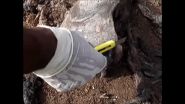(Press-News.org) Washington, DC -- The planet's soil releases about 60 billion tons of carbon into the atmosphere each year, which is far more than that released by burning fossil fuels. This happens through a process called soil respiration. This enormous release of carbon is balanced by carbon coming into the soil system from falling leaves and other plant matter, as well as by the underground activities of plant roots.
Short-term warming studies have documented that rising temperatures increase the rate of soil respiration. As a result, scientists have worried that global warming would accelerate the decomposition of carbon in the soil, and decrease the amount of carbon stored there. If true, this would release even more carbon dioxide into the atmosphere, where it would accelerate global warming.
New work by a team of scientists including Carnegie's Greg Asner and Christian Giardina of the U.S. Forest Service used an expansive whole-ecosystem study, the first of its kind, on tropical montane wet forests in Hawaii to sort through the many processes that control soil carbon stocks with changing temperature. Their work is published in Nature Climate Change.
The team revealed that higher temperatures increased the amount of leaf litter falling onto the soil, as well as other underground sources of carbon such as roots. Surprisingly, long-term warming had little effect on the overall storage of carbon in the tropical forest soil or the rate at which that carbon is processed into carbon dioxide.
"If these findings hold true in other tropical regions, then warmer temperatures may not necessarily cause tropical soils to release their carbon to the atmosphere at a faster rate," remarked Asner. "On the other hand, we cannot expect that the soil will soak up more carbon in places where vegetation is stimulated by warmer temperatures. Unlike tropical trees, the soil seems to be on the sidelines in the climate adaptation game."
This means the observed increase in the rate of soil respiration accompanying rising temperatures is due to carbon dioxide released by the an uptick in the amount of litter falling on the forest floor and an increase in carbon from underground sources. It is not from a decrease in the overall amount of carbon stored in the soil.
Giardina noted "While we found that carbon stored in the mineral soil was insensitive to long-term warming, the loss of unprotected carbon responded strongly to temperature. This tells us that the sensitivity of each source of soil respiration needs to be quantified, and the aggregate response examined, before an understanding of ecosystem carbon balance in a warmer world can be achieved."
INFORMATION:
This work was funded by the National Science Foundation, the College of Tropical Agriculture and Human Resources at the University of Hawaii at Manoa, the USDA Forest Service, and the Carnegie Institution for Science.
The Carnegie Airborne Observatory is made possible by the Avatar Alliance Foundation, John D. and Catherine T. MacArthur Foundation, Grantham Foundation for the Protection of the Environment, Gordon and Betty Moore Foundation, W. M. Keck Foundation, the Margaret A. Cargill Foundation, Mary Anne Nyburg Baker and G. Leonard Baker Jr., and William R. Hearst III.
The Carnegie Institution for Science is a private, nonprofit organization headquartered in Washington, DC, with six research departments throughout the U.S. Since its founding in 1902, the Carnegie Institution has been a pioneering force in basic scientific research. Carnegie scientists are leaders in plant biology, developmental biology, astronomy, materials science, global ecology, and Earth and planetary science.
Climate change and the soil
Climate warming may not drive net losses of soil carbon from tropical forests
2014-07-23
ELSE PRESS RELEASES FROM THIS DATE:
AGU: Voyager spacecraft might not have reached interstellar space
2014-07-23
WASHINGTON, D.C. -- In 2012, the Voyager mission team announced that the Voyager 1 spacecraft had passed into interstellar space, traveling further from Earth than any other manmade object.
But, in the nearly two years since that historic announcement, and despite subsequent observations backing it up, uncertainty about whether Voyager 1 really crossed the threshold continues. There are some scientists who say that the spacecraft is still within the heliosphere – the region of space dominated by the Sun and its wind of energetic particles – and has not yet reached the ...
Wide-faced men negotiate nearly $2,200 larger signing bonus
2014-07-23
RIVERSIDE, Calif. -- Having a wider face helps men when they negotiate for themselves but hurts them when they are negotiating in a situation that requires compromise. Additionally, men who are more attractive are better collaborators compared to less attractive men.
Those are among the findings outlined in a just published paper co-authored by Michael P. Haselhuhn and Elaine M. Wong, assistant professors of management at the University of California, Riverside's School of Business Administration. The paper describes four negotiation simulations set up by the authors ...
This week from AGU: Oso report, rockfall in Yosemite Park, and a new ear
2014-07-23
From AGU's blogs: Oso disaster had its roots in earlier landslides
A research team tasked with being some of the first scientists and engineers to evaluate extreme events has issued its findings on disastrous Oso, Washington, landslide. The report studies the conditions and causes related to the March 22 mudslide that killed 43 people and destroyed the Steelhead Haven neighborhood in Oso, Washington. The team from the Geotechnical Extreme Events Reconnaissance (GEER) Association, funded by the National Science Foundation, determined that intense rainfall in the three ...
Protein evolution follows a modular principle
2014-07-23
This news release is available in German.
Proteins impart shape and stability to cells, drive metabolic processes and transmit signals. To perform these manifold tasks, they fold into complex three-dimensional shapes. Scientists at the Max Planck Institute for Developmental Biology in Tübingen have now discovered that proteins can be constructed of similar amino acid chains even when their three-dimensional shapes differ significantly. This suggests that the proteins that exist today arose from common precursors. Presumably, in the course of evolution they were ...
Dead body feeding larvae useful in forensic investigations
2014-07-23
VIDEO:
This image depicts Chrysomya megacephala larvae on decomposing fish.
Click here for more information.
Non-biting blow fly Chrysomya megacephala is commonly found in dead bodies and is used in forensic investigations to determine the time of death, referred to as the post mortem interval. A report of synanthropic derived form of C. megacephala from Tamil Nadu is provided for the first time based on morphological features and molecular characterization through generation ...
Study provides new perspectives on the current Clostridium difficile epidemic
2014-07-23
PASADENA, Calif., July 23, 2014 — More than 80 percent of hospitalized patients who tested positive for Clostridium difficile were tested outside the hospital or within the first 72 hours of hospitalization, suggesting that settings outside of the hospital may play key roles in the identification, onset and possible transmission of the disease, according to a new Kaiser Permanente study published today in the journal Mayo Clinic Proceedings.
The study provides new insight into the contagious and potentially deadly infection also known as C. diff, a bacterium most often ...
Nano-sized chip "sniffs out" explosives far better than trained dogs
2014-07-23
Security forces worldwide rely on sophisticated equipment, trained personnel, and detection dogs to safeguard airports and other public areas against terrorist attacks. A revolutionary new electronic chip with nano-sized chemical sensors is about to make their job much easier.
The groundbreaking nanotechnology-inspired sensor, devised by Prof. Fernando Patolsky of Tel Aviv University 's School of Chemistry and Center for Nanoscience and Nanotechnology, and developed by the Herzliya company Tracense, picks up the scent of explosives molecules better than a detection dog's ...
Statin use decreases the risk of Barrett's esophagus
2014-07-23
Bethesda, MD (July 23, 2014) — Statins, a class of drugs commonly used to lower cholesterol levels, significantly reduce a patient's risk of developing Barrett's esophagus, according to a new study in Gastroenterology1, the official journal of the American Gastroenterological Association. Obese patients experienced the greatest level of risk reduction with statin use.
"Patients who received statins had a 43 percent reduction in the odds of having Barrett's esophagus compared to non-users," said study author Hashem B. El-Serag, MD, MPH, from the Houston VA Medical Center ...
Rosemary and oregano contain diabetes-fighting compounds
2014-07-23
The popular culinary herbs oregano and rosemary are packed with healthful compounds, and now lab tests show they could work in much the same way as prescription anti-diabetic medication, scientists report. In their new study published in ACS' Journal of Agricultural and Food Chemistry, they found that how the herbs are grown makes a difference, and they also identified which compounds contribute the most to this promising trait.
Elvira Gonzalez de Mejia and colleagues point out that in 2012, type-2 diabetes affected more than 8 percent of Americans and cost the country ...
The geography of the global electronic waste ('e-waste') burden
2014-07-23
As local and national governments struggle to deal with ever-growing piles of electronic waste (or "e-waste"), scientists are now refining the picture of just how much there is and where it really ends up. Published in the ACS journal Environmental Science & Technology, their study found that nearly a quarter of e-waste that developed countries discard floods into just seven developing countries — with major potential health risks for the people who live there.
Knut Breivik and colleagues note that the export from developed to developing regions of e-waste — everything ...
LAST 30 PRESS RELEASES:
Personalised “cocktails” of antibiotics, probiotics and prebiotics hold great promise in treating a common form of irritable bowel syndrome, pilot study finds
Experts developing immune-enhancing therapies to target tuberculosis
Making transfusion-transmitted malaria in Europe a thing of the past
Experts developing way to harness Nobel Prize winning CRISPR technology to deal with antimicrobial resistance (AMR)
CRISPR is promising to tackle antimicrobial resistance, but remember bacteria can fight back
Ancient Maya blessed their ballcourts
Curran named Fellow of SAE, ASME
Computer scientists unveil novel attacks on cybersecurity
Florida International University graduate student selected for inaugural IDEA2 public policy fellowship
Gene linked to epilepsy, autism decoded in new study
OHSU study finds big jump in addiction treatment at community health clinics
Location, location, location
Getting dynamic information from static snapshots
Food insecurity is significant among inhabitants of the region affected by the Belo Monte dam in Brazil
The Society of Thoracic Surgeons launches new valve surgery risk calculators
Component of keto diet plus immunotherapy may reduce prostate cancer
New circuit boards can be repeatedly recycled
Blood test finds knee osteoarthritis up to eight years before it appears on x-rays
April research news from the Ecological Society of America
Antimicrobial resistance crisis: “Antibiotics are not magic bullets”
Florida dolphin found with highly pathogenic avian flu: Report
Barcodes expand range of high-resolution sensor
DOE Under Secretary for Science and Innovation visits Jefferson Lab
Research expo highlights student and faculty creativity
Imaging technique shows new details of peptide structures
MD Anderson and RUSH unveil RUSH MD Anderson Cancer Center
Tomography-based digital twins of Nd-Fe-b magnets
People with rare longevity mutation may also be protected from cardiovascular disease
Mobile device location data is already used by private companies, so why not for studying human-wildlife interactions, scientists ask
Test reveals mice think like babies
[Press-News.org] Climate change and the soilClimate warming may not drive net losses of soil carbon from tropical forests


